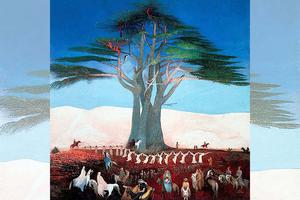11th Sunday in Ordinary Time: Choosing the Apostles
SCRIPTURES & ART: Today’s Gospel underscores a critical aspect of the Church: her apostolicity.

The Church now settles in for the long haul of Ordinary Time, which will last until Dec. 2. (With Christmas falling on Monday, this year’s Advent is the shortest it can be). But Ordinary Time should be anything but “ordinary.” It is a time for systematic focus on Jesus’s life and teaching, guided in each of three years by one of the Synoptic Evangelists. This year, we are under Matthew’s tutelage.
There is usually a great focus on the call of the Apostles in the period of Ordinary Time that falls between Christmastide and Lent. Matthew mentioned the call of the Peter, Andrew, James and John on the Third Sunday of Ordinary Time but then the Lectionary for Year A turned to a more extended exposure of the Sermon on the Mount and Jesus’s related teaching in Matthew 5. That — and the fact that the Gospel for the Third Sunday of Ordinary Time does not mention the other Apostles — makes it fitting that we return to the apostolic call at the start of this period of Ordinary Time.
The call of the Apostles is clearly connected with ministry. Jesus pities “the crowds” who are “troubled and abandoned,” lacking shepherds to alleviate their lot and help shoulder their yokes. Shepherds are not self-appointed: they are sent by the Master of the Harvest.
Jesus wants to send shepherds who will deal with everything that “troubles” the crowd. The first “trouble” to be addressed — man’s basic problem — is evil, and he gives the shepherds “authority over unclean spirits.” Because man is a whole, and because suffering and death are presented biblically as punishments for and tied with man’s fall (though not on a one-to-one basis — see John 9:1-38), he also gives them authority over physical infirmity. (The Sacrament of Anointing of the Sick is a perfect illustration of these priorities. Its primary purpose is spiritual healing, but it also affords physical healing should God will it).
There immediately follows the catalog of the Apostles by name (because God “calls [us] by name” — Isaiah 43:1).
Today’s Gospel underscores a critical aspect of the Church: her apostolicity. Every Sunday in the Profession of Faith, we declare our belief in “one, holy, catholic and apostolic Church.” These four aspects, or “notes” of the Church, are her essential features.
Apostolicity is an essential feature of the Church, its makeup, and governance. Jesus has many followers: there are “crowds.” But Jesus clearly distinguishes between the “crowds” and his chosen Apostles, who are given specific tasks and functions vis-à-vis those people.
The Catholic Church stands on the authority and witness of those Apostles. The Church speaks of the bishops as “successors” of the Apostles. The Church stands on her apostolic faith. Catholicism reaches back through the Apostles to Jesus. It’s not “Luther’s” church or an “episcopal church” of royally-appointed functionaries.
We saw this truth just last month, when the Church celebrated the feast of St. Matthias. Judas shows us that Apostles (and, by analogy, their successors) can betray the faith. But the remaining Apostles did not leave his place empty, did not leave a hole in the apostolic college. They did not see their twelvesome as some temporary arrangement, applicable only to them and not to be perpetuated in the Church. St. Peter makes clear that the vacancy caused by Judas’ defection and death has to be filled and, after invoking the Holy Spirit, St. Matthias is added to the Apostles.
Today’s Gospel is illustrated by our go-to artist for biblical imagery, the late-19th-century French painter James Tissot. “Election de douze” [“The Choice of the Twelve”] captures the moment as Jesus completes the choice of his Apostles.
Against an accurate landscape of Israel, Jesus is selecting Apostles. Ten already stand atop a hill. One appears to be on his way to join them, halfway up the hill, staff in hand. Jesus stands at the foot of the hill, his right hand pointing at a man, his left hand pointing to where that man should go. The others have made their choices to respond to Jesus’s invitation: now, heaven and history look at a concrete man, awaiting whether and how he will decide to answer the Lord’s call.
The locale seems particularly appropriate. Jesus does not promise his followers — and certainly not his Apostles — a rose garden. Theirs will be “an uphill battle.” They will need to climb across, maybe even stumble on rocks. They are blessed as long as they do not find in him a stumbling block in Jesus, something Judas will (Matthew 11:6; 1 Peter 2:7-8).
Today’s painting, like much of the Tissot collection, is held by the Brooklyn Museum.
- Keywords:
- 11th Sunday in ordinary time
- scriptures & art

















